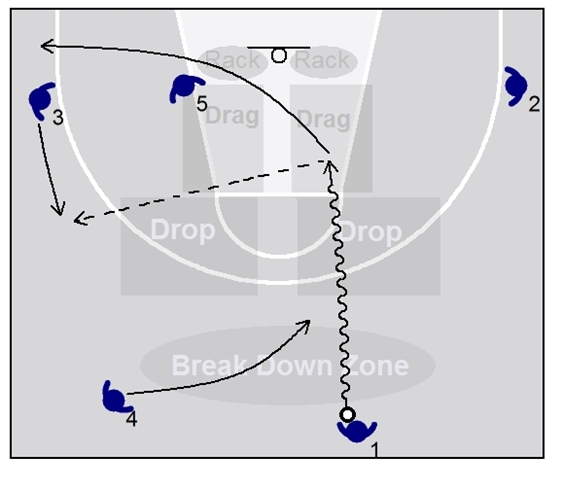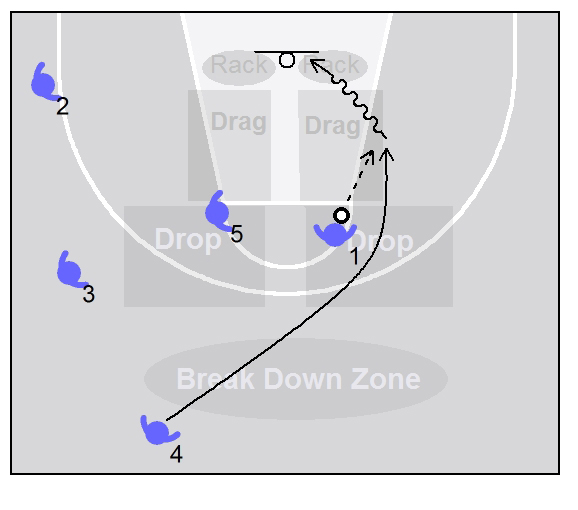Your cart is currently empty!
Tag: Dribble Drive
Name of the offense
Dribble Drive Fast Break; The Spurs Way
I read an interesting blog post today (via TrueHoop). It’s interesting because to me it reads like an article about how to run the dribble drive fast break, and especially how hard it is to stop a player who attacks the basket at speed. And this is at the highest level, with the San Antonio Spurs.
Here’s the interesting quote:
In watching San Antonio, it doesn’t even feel like they’re looking to run fast breaks as a team, it really just feels like Parker increasingly looks to take off on one-man forays. Usually, TP breaks one of the cardinal rules of transition basketball: he never has the numbers. Really, almost never. He converts at an amazing rate, considering that he always seems to be going 1-on-3 or 2-on-3.
This phenomenon really stood out to me in San Antonio’s 103-94 win over Chicago on Nov. 17. I went back at looked at Parker’s clips on Synergy Sports for that game. For the season, Parker has been producing about 1.3 points per possessions (PPP) on transition plays, a strong rate. In the game vs. the Bulls, he was credited with 11 points on 5 transition plays (2.2 PPP). I mean, the Bulls are a good defensive team that plays hard – this is a crazy number. Indeed, a play-by-play analysis of the video showed that the Bulls were getting back on defense… but they still couldn’t stop Parker. Here’s a play-by-play breakdown:
1) 2-on-3 break: TP Bucket
2) 1-on-3 break (4th defender collapses at end): TP Bucket
3) 3-on-3 break (4th defender chases in at end): TP Bucket And 1
4) 2-on-3 break: TP Bucket
5) 2-on-3 break: TP BucketNot once did Parker have the numbers, yet he converted every single time. Another thing I noticed is that, on any break above where it was 2-on-3 or 3-on-3, the non-Parker Spurs always looked to spot up behind the three-point line, rather than run to the basket, and were really trailers more than what we commonly think of as active participants in fast breaks.
It really might be the most bizarre fast-break approach I’ve seen: they have one little guy who gets the ball and dribbles like crazy, as he runs a one-man break which he can finish uncommonly well, even against the numbers, and even though he’s not a physically dominating guy – he essentially can’t even dunk in a game! And his teammates don’t even look to run to the basket, they’re just running to the line.
So Parker can go 1-on-3 and still score. An experienced Dribble Drive coach shouldn’t be too surprised; We know that when a offensive player is at full speed and is driving to the rim at full speed it’s almost impossible to stop him without fouling him.
We know this from running the Blood Drills every day.
Obviously most our players can’t finish like Parker, which is why we have the post to clean up the misses, but the principle is the same.
Staying true to your style
I think one of the most important things you must do when running any offense is to stay true to it with everything you do. By that I mean that you can’t teach two different styles of play and expect the players to understand both and especially be able to play both.
If you’re running the Dribble Drive, I think it becomes very hard to run a slow-down offense as a secondary offense – and don’t even think about running the DDM as a secondary offense.
You have to get your players into the right mindset. If you’re running a screening motion, you have to instill patience and if you’re running the DDM they have to be in attack mode.
When I started running the DDM we would walk it up, make sure everybody were in the right position, and then start running it. In other words, we were relying on the X’s and O’s to provide the baskets, and ran it like you run sets. The problem was that the players never got into the right attack mindset.
That’s where I think both Calipari and Walberg have revolutionized the game in a way. There is no fast or secondary break. In it’s purest form both use the DDM where they are just attacking off a basket or a rebound. The ball must be pushed, and it can go anywhere going up the court, and no matter where the ball goes you just follow the basic Dribble Drive principles
While with the Dribble Drive you have to be in attack mode 100% of the time, you might also be forced to run sets and quick hitters. There’s nothing wrong with that, but I wouldn’t use sets which change the mind-set of the players. Quick hitters or sets may be useful to open up the defense for the Dribble Drive, but don’t ask the players to run complicated sets that require patience and a different mind set.
Video reviews
One thing I hear a lot of questions about is the various DVD sets about the Dribble Drive Motion. Are they any good? Are they good enough? Who are they for? Below I’ll review the DDM DVD’s I’ve seen.
(more…)
Swim Move
In The Dribble Drive Motion – An Instruction Manual I talk at length about the fundamentals of attacking 1-on-1, inspired by coach Dave Smart of Carleton University, Canada. I players are much more effective when they use the swim move, and at the 1:55 mark in the video below you will see how it works against the number 1 NBA draft pick John Wall:
[youtube=http://www.youtube.com/watch?v=whVEiYap1F4&w=640&h=385&rel=0&hd=1]
Notice how Jeremy Lin reaches out with his left arm and keeps Wall on his side for the entire drive. The commentators say that Wall has to work on his “D”, but once the swim move is established it’s almost impossible to recover.
Also look at the 5:06 mark where Lin blows by his man. Again he uses the felt arm to create leverage effectively, and that’s why I teach the swim move.
Out-of-Season Player Development
I think there are two kinds of player development: In-practice and out-of-practice development. In-practice the Dribble Drive is really good – out-of-practice it’s excellent! (more…)
Drag 2 to the 3 – where to go next?
On a Drag 2 drive with a pass to the 3, the question has been asked where the 1 should go after the pass, if you want to take advantage of the post.
 Wallberg has the 1 go to the 3-corner after the pass, as shown here.
Wallberg has the 1 go to the 3-corner after the pass, as shown here.The question posed is if it wouldn’t be better if the 1 goes opposite, as to not clog up the middle with his defender?
I think that solution poses several problems, as I’ll explain below.
.
The Drop Zone Extended
 I don’t claim that the way we’re running the dribble drive is much different than what other people runs – in fact most of it is just taking the best of Walberg’s and Calipari’s options and combining them. We do try to look out for new options, though, and a few of them end up being part of the way we run the offense.
I don’t claim that the way we’re running the dribble drive is much different than what other people runs – in fact most of it is just taking the best of Walberg’s and Calipari’s options and combining them. We do try to look out for new options, though, and a few of them end up being part of the way we run the offense.During preseason we’ve experimented with new options and one option is really standing out. As a part of the way we teach the offense we don’t teach the drop zone kick-up until we’ve put everything else in and can run it really well, as that option very easily becomes the primary option, and we feel the offense has much better options.
Because of this we’ve had a chance to really look at the drop zone back door options, and we’ve added a wrinkle inspired by Calipary, but which fits in really well with Walbergs original offense.
